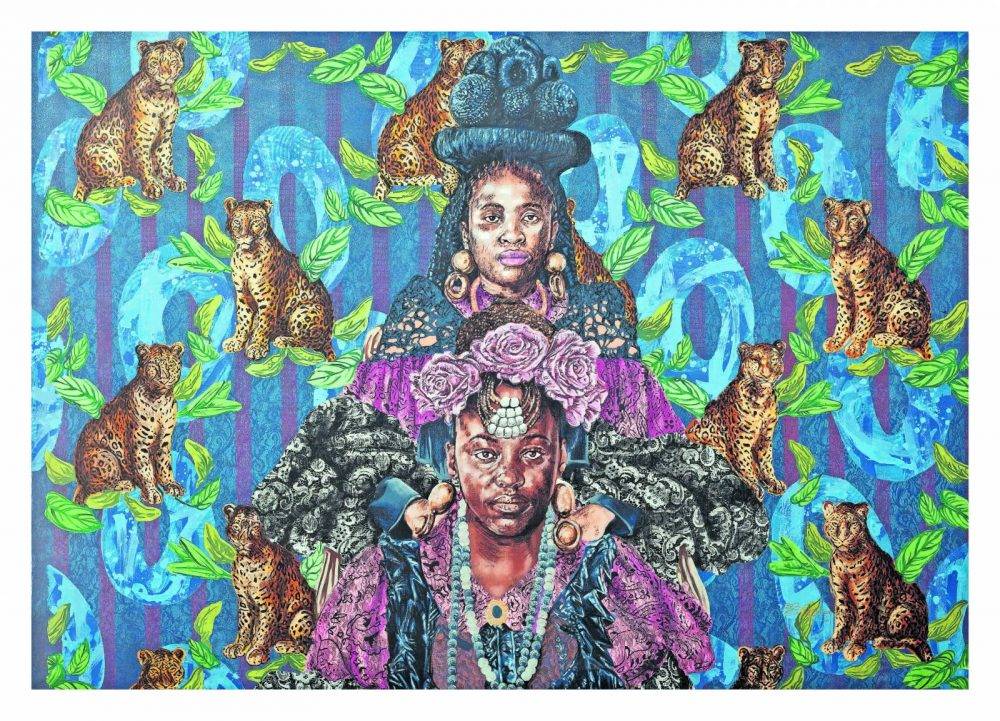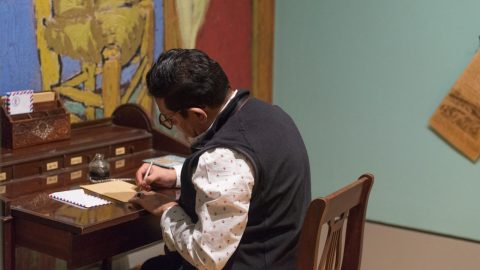
Bambo Sibiya’s exhibition Ngemva Kokuqubuka (After Precarity), on at the Circa Gallery in Rosebank, Johannesburg, until 27 July, features work such as Minki and Hlehle. Photo supplied
Acclaimed South African visual artist Bambo Sibiya explores socio-economic challenges and resilience in the face of adversity in his latest exhibition titled Ngemva Kokuqubuka (After Precarity).
“This is my first exhibition in seven years, after exhibiting internationally,” he tells me at Johannesburg’s Circa Gallery.
“I am excited and, so far, people have received the work beautifully. It has not been easy because as soon as you put out your work, you expose it to critics, art lovers and everyone else in between,” says the 33-year-old.
It was important for Sibiya to exhibit internationally as he says the art scene in South Africa is small and is still evolving.
“The biggest platforms in the art world are overseas. You look at the European art market, the American art market, as well as the art market in Japan, and you don’t want to lose the opportunity to get on that boat,” he says.
But it is just as important to come back home and exhibit and share what South Africa has.
“What’s the point of cooking and feeding the outside world and forgetting about yourself? That’s why it was important for me to come back home and do this.”
This exhibition is more than a homecoming, it is a collection of works that pay homage to his mother. He elaborates by pointing at a painting titled Minki and Hlehle, which tells the story of his mother in many forms.
It is of two poised women, one is sitting, while the other stands behind her. They are beautiful, regal and calm. The painting feels as if it fills the whole room.
“It is difficult to find someone to fill my mother’s shoes; it is almost an impossible task.
“When I look at that piece, I see my mom and my sister. They may look young but that’s not what they stand for — I see my mom shielding my sister,” he shares.
“When I made that piece, I wanted to show how majestic she is — I kept asking myself, ‘How can I put that across in a painting?’ I had to show how she is a woman of authority and how she is in control.
“Sometimes you get a look from your mother that communicates a lot and you know exactly what to do. I needed that to come across in this painting,” he says.
Sibiya’s work is known for its striking visual narratives and deep-rooted commentary on African identity and social conditions — Ngemva Kokuqubuka (After Precarity) subtly continues that message.
It sets the stage for a powerful examination of life beyond uncertainty and instability. The exhibition delves into the effects of precarious living conditions, offering a narrative of survival, adaptation and hope.
Sibiya’s work grapples with the tension between vulnerability and strength, capturing moments of both struggle and triumph.
“The whole show is blue and pink.
“Blue is a very powerful colour — it is the colour of the ocean and it is the colour of the sky. It can be beautiful and it can be a very strong and intimidating colour,” he says.
The pink notes bring softness and femininity to the works, and when you look at them from different angles, you see glitter, which he says gives the effect of stars in a navy-blue sky — sometimes you see them and sometimes you don’t.
This creates fluidity and movement in the works.
Sibiya’s distinctive style merges traditional African aesthetics with contemporary techniques, creating a dynamic visual language that resonates deeply with viewers.
His use of bold lines, intricate patterns and rich textures brings to life the stories of individuals and communities navigating precarious circumstances.
Sibiya’s mastery of printmaking is evident in the detailed and emotive quality of each piece.
His art serves as both a mirror and a window, reflecting the realities of many South Africans while offering a glimpse of their resilience and capacity for change.
Visitors are moved by the emotional depth and authenticity of Sibiya’s work, with many noting their powerful storytelling capacity and intricate craftsmanship.
While I was admiring one of the works, a fellow art enthusiast stood next to me. I usually attend these things alone so, sometimes, after putting my shyness aside, I chat to others and hear their opinions about the work.
“Beautiful, right?” I ask.
She smiles and says: “I love how he celebrates black women in the most subtle, yet bold, way — using faces.
“A lot of the time, the depiction of black women can be a bit much and, in a way, that ultimately feels like the whole world sees us like that. This is so refreshing.”
Sibiya says one of the aims of this collection is to sell it, as he is a commercial artist, but another is to open international doors.
“After this, I am expecting more invites internationally — more art fairs and residencies.
“I think I did push boundaries with this collection, hoping that I can attract the right people.”
The exhibition runs until 27 July at the Circa Gallery in Rosebank, Johannesburg.







